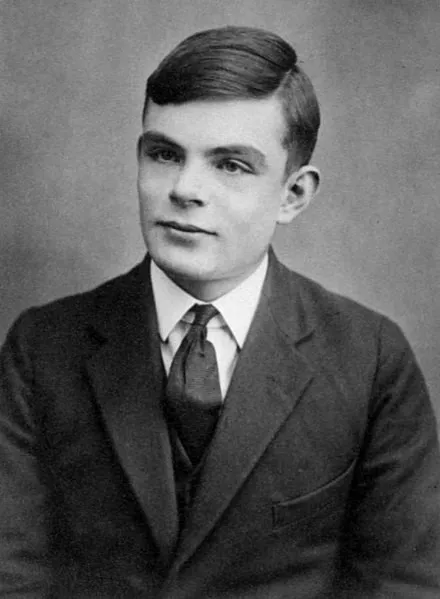Have you ever wondered if machines could transcend their programming and imitate human thought? Imagine a test so challenging that, when applied to a machine, it could reveal whether it is capable of 'thinking' like a human being.
Welcome to the intriguing world of the Turing Test, a revolutionary idea that makes us question the limits of artificial intelligence.
In this article, we'll delve into the brilliant mind of Alan Turing and explore the fascinating journey of discovering whether machines can achieve a level of intelligence that resembles our own thinking.
Who was Alan Turing?

Alan Turing (1912-1954) - Photo: Reproduction/Encyclopedia Britannica
Alan Turing was a British mathematician, logician and computer scientist who lived from 1912 to 1954. He is widely regarded as one of the most influential figures in the development of computer science and artificial intelligence, and has even been called the "Father of Computing".
Turing made a number of significant contributions to various fields, and his life and work had a lasting impact on technology and scientific research. Here are some of his most notable articles:
"On Computable Numbers, with an Application to the Decision Problem" (1936)
Alan Turing introduced the concept of a "Turing machine", a theoretical abstraction that showed that algorithms could be executed by mechanical devices. He used this machine to tackle the "decision problem", demonstrating that it was impossible to solve in general.
This article laid the foundations for the theory of computing and is often considered to be the starting point for computer science.
"On Computable Numbers, with an Application to the Decision Problem. A Correction" (1936-1937)
This article is a correction to the first, in which Turing made adjustments and refinements to the concept of the Turing machine and the theory of computability
He further clarified the fundamental principles of computing, consolidating the foundations of the theory of computability.
"Computing Machines and Intelligence" (1950)
Turing proposed the "Turing Test", which has become an important reference in the field of artificial intelligence.
He discussed the ability of machines to exhibit intelligent behavior and suggested that a machine could be considered "intelligent" if it could hold a written conversation with a human being without the human being able to distinguish whether it was communicating with a machine.
What is the Turing Test?
The Turing Test is a concept in the field of AI and philosophy of mind. The test was designed to evaluate a machine's ability to exhibit intelligent behavior without relying on its resemblance to human thought.
The Turing Test emphasizes the machine's ability to communicate convincingly and naturally, simulating human intelligence. It is not based on real comprehension or consciousness, but on a machine's ability to carry out an interaction that is indistinguishable from that of a human being.
How the Turing Test Works

(Schematic of the classic Turing test)
See a detailed description of how the Turing Test works:
Three participants: The test involves three participants: a human being (the interrogator), a machine and another human being. The interrogator is tasked with holding a written conversation with both, but doesn't know which is which.
Written communication: communication between the interrogator and the entities (the machine and the human being) is done in writing, usually by means of a computer.
Objective: The aim of the test is to determine whether the machine can carry on a conversation in such a way that the interrogator cannot distinguish which entity (the machine or the human being) is responding.
Questions and Answers: the interrogator asks a series of questions to the two entities, which also answer the questions in writing. The entities' answers are based on text, and the interrogator must evaluate the quality of the answers to determine which entity is generating the answers.
Pass: if the interrogator cannot correctly determine which entity is the machine and which is the human being based on its answers, the machine is considered to have passed the Turing Test. This suggests that the machine has been able to simulate intelligent behavior indistinguishable from that of a human being in written conversation.
Importance of the Turing Test for the Development of AIs

The Turing Test has played a key role in the development of artificial intelligences (AIs) for several reasons.
It represents a fundamental challenge in AI, encouraging researchers to create systems that can understand, reason, learn and communicate as effectively as human beings.
In addition, the focus on conversational capability is one of the most visible and valuable applications of AI in today's society, driving the development of voice assistants such as Siri, Alexa and Google Assistant and advanced chatbots.
The Turing Test also provides an objective evaluation metric for machine intelligence, defining success as a machine's ability to fool a human judge in a conversation.
This sets clear standards for measuring progress in AI and stimulates ongoing research in areas such as natural language processing, machine learning and pattern recognition.
Over the years, various competitions and challenges, such as the Loebner Prize, have been organized based on the concept of the Turing Test. And the result is top performance in areas such as customer service, technical support, e-commerce and much more.
These initiatives not only raise awareness of AI advances, but also motivate researchers to improve their approaches, driving the development of more complex algorithms and language models, such as ChatGPT.
Limitations of the Turing Test
The Turing Test has some limitations and criticisms:
- Lack of objective definition of intelligence: the Turing Test is based on the ability of a machine to fool a human judge in a conversation, but it does not offer an objective or precise definition of what intelligence is;
- Emphasis on conversation: the emphasis on conversational ability may not be the only measure of intelligence. There are many other forms, such as pattern recognition, machine learning and problem solving, which are not addressed by the Turing Test;
- False negatives and false positives: The Test can lead to false negatives, where an intelligent machine does not pass the test due to technical or communication issues, and false positives, where a machine that is not truly intelligent can fool a human judge for a short period of time;
- Dependence on human subjectivity: it depends on the judgment of human beings as judges to determine the machine's intelligence. This subjectivity can lead to inconsistent and biased results;
- It does not address ethics: the Test does not deal with important ethical issues related to AI, such as privacy, security and responsibility. The mere ability of a machine to impersonate a human does not address these fundamental concerns.
Contributions of the Turing Test

Here are some of the contributions of the Turing Test to the present day.
Development of Chatbots and Virtual Assistants
The Turing Test established a fundamental challenge in the field of AI: to create conversational systems that could pass for human in a textual interaction. This has driven the development of chatbots and virtual assistants that seek to communicate convincingly and naturally with users.
It has served as an objective and benchmark for the creation of increasingly sophisticated conversational systems, motivating companies and researchers to improve the ability of chatbots and virtual assistants to answer questions and maintain more contextual and intelligent dialogues.
Research in Natural Language Processing (NLP)
The Turing Test encouraged advances in NLP research, with a focus on understanding and generating human language.
In addition, the Turing Test has stimulated research in areas such as machine translation, sentiment analysis, text summarization and entity recognition, contributing to improvements in a variety of NLP applications.
Raising awareness of AI
The Turing Test had a major impact on public awareness of AI. The challenge of creating machines that can impersonate humans in conversation has generated widespread interest and curiosity around artificial intelligence.
This has led to an increase in public understanding and interest in AI and its capabilities, as well as a deeper appreciation of the challenges and potential of this technology.
Ethical development of AI
The Turing Test triggered discussions about ethics and responsibility in the development of AI. As machines become more capable of impersonating humans, ethical concerns arise around issues such as transparency, privacy and manipulation.
The quest to achieve the level of human "intelligence" in machines has raised questions about how to ensure that AI is used ethically and responsibly, promoting discussions about regulation and ethical guidelines in the field of AI.
Conclusion
The Turing Test left a remarkable legacy in the history of artificial intelligence, and today AI is an undeniable presence in our lives. To make the most of its potential in optimizing various areas, it is imperative that you are well informed and engaged with this technology.
Awareness, understanding and ethical considerations are essential as the future integrates AI into almost every daily action, ensuring that it continues to improve your days and drive your business forward in a responsible and efficient way.
-
Related articles:
💡 1 6 Examples of Artificial Intelligence in Your Daily Life
💻 What Machine Learning Is, How It Works and Application Examples
🧑🚀 Generative AI: What Is It, What Are Its Benefits and Applications?



